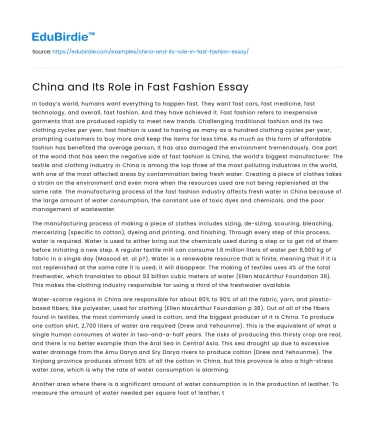In today’s world, humans want everything to happen fast. They want fast cars, fast medicine, fast technology, and overall, fast fashion. And they have achieved it. Fast fashion refers to inexpensive garments that are produced rapidly to meet new trends. Challenging traditional fashion and its two clothing cycles per year, fast fashion is used to having as many as a hundred clothing cycles per year, prompting customers to buy more and keep the items for less time. As much as this form of affordable fashion has benefited the average person, it has also damaged the environment tremendously. One part of the world that has seen the negative side of fast fashion is China, the world’s biggest manufacturer. The textile and clothing industry in China is among the top three of the most polluting industries in the world, with one of the most affected areas by contamination being fresh water. Creating a piece of clothes takes a strain on the environment and even more when the resources used are not being replenished at the same rate. The manufacturing process of the fast fashion industry affects fresh water in China because of the large amount of water consumption, the constant use of toxic dyes and chemicals, and the poor management of wastewater.
The manufacturing process of making a piece of clothes includes sizing, de-sizing, scouring, bleaching, mercerizing (specific to cotton), dyeing and printing, and finishing. Through every step of this process, water is required. Water is used to either bring out the chemicals used during a step or to get rid of them before initiating a new step. A regular textile mill can consume 1.6 million liters of water per 8,000 kg of fabric in a single day (Masood et. al p?). Water is a renewable resource that is finite, meaning that if it is not replenished at the same rate it is used, it will disappear. The making of textiles uses 4% of the total freshwater, which translates to about 93 billion cubic meters of water (Ellen MacArthur Foundation 38). This makes the clothing industry responsible for using a third of the freshwater available.
Water-scarce regions in China are responsible for about 80% to 90% of all the fabric, yarn, and plastic-based fibers, like polyester, used for clothing (Ellen MacArthur Foundation p 38). Out of all of the fibers found in textiles, the most commonly used is cotton, and the biggest producer of it is China. To produce one cotton shirt, 2,700 liters of water are required (Drew and Yehounme). This is the equivalent of what a single human consumes of water in two-and-a-half years. The risks of producing this thirsty crop are real, and there is no better example than the Aral Sea in Central Asia. This sea drought up due to excessive water drainage from the Amu Darya and Sry Darya rivers to produce cotton (Drew and Yehounme). The Xinjiang province produces almost 50% of all the cotton in China, but this province is also a high-stress water zone, which is why the rate of water consumption is alarming.
Another area where there is a significant amount of water consumption is in the production of leather. To measure the amount of water needed per square foot of leather, the steer or cow’s lifecycle needs to be taken into consideration. Most of the water needed for the production of leather is consumed by the animal, the rest is used for beamhouse operations and during the usage of chemicals. PrimeAsia is a leather manufacturing company in China with an average of 3.3 liters per square foot of leather (Swenson). If the water consumed by the animal during its lifetime is not considered, PrimeAsia utilizes 56% of water for beam house processes, 33% during the usage of chemicals, and 11% in tanneries (Swenson). In 2000, it was estimated that the water consumption by this specific part of the industry was 30 billion liters of water annually (Sundar et. al 443). It has reduced since then, but it is still a disquieting number. This usage of water is preoccupying because of the use of underground water, which is supposed to be our backup plan in case we run out of water (“Nothing to Hide”). Nowadays, China is the main leather-producing country, with the major manufacturers in the Guangdong, Fujian, Zhejiang, and Hebei provinces.
For the clothes to obtain any type of color, the fibers used need to be dyed or printed. Dyeing is used for unicolor results whereas printing allows a scope of more colors at the same time. During this process, several types of chemicals, it is estimated that as many as 2,000, are used. These chemicals have diverse compositions and can be divided into textile auxiliaries and textile chemicals (Masood et. al p?). Textile auxiliaries are used for cleaning natural fibers and as smoothing agents (Masood et. al p?). Among the chemicals used are complexing, wetting, sequestering, and dispersing agents as well as surfactants and emulsifiers (Masood et. al p?). Textile chemicals include colorants






 Stuck on your essay?
Stuck on your essay?

